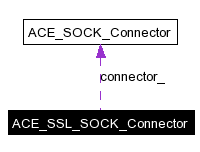
#include <SSL_SOCK_Connector.h>
Collaboration diagram for ACE_SSL_SOCK_Connector:

Public Types | |
| typedef ACE_INET_Addr | PEER_ADDR |
| typedef ACE_SSL_SOCK_Stream | PEER_STREAM |
Public Member Functions | |
| ACE_SSL_SOCK_Connector (void) | |
| Default constructor. | |
| ACE_SSL_SOCK_Connector (ACE_SSL_SOCK_Stream &new_stream, const ACE_Addr &remote_sap, const ACE_Time_Value *timeout=0, const ACE_Addr &local_sap=ACE_Addr::sap_any, int reuse_addr=0, int flags=0, int perms=0) | |
| ACE_SSL_SOCK_Connector (ACE_SSL_SOCK_Stream &new_stream, const ACE_Addr &remote_sap, ACE_QoS_Params qos_params, const ACE_Time_Value *timeout=0, const ACE_Addr &local_sap=ACE_Addr::sap_any, ACE_Protocol_Info *protocolinfo=0, ACE_SOCK_GROUP g=0, u_long flags=0, int reuse_addr=0, int perms=0) | |
| ~ACE_SSL_SOCK_Connector (void) | |
| Default dtor. | |
| int | connect (ACE_SSL_SOCK_Stream &new_stream, const ACE_Addr &remote_sap, const ACE_Time_Value *timeout=0, const ACE_Addr &local_sap=ACE_Addr::sap_any, int reuse_addr=0, int flags=0, int perms=0) |
| int | connect (ACE_SSL_SOCK_Stream &new_stream, const ACE_Addr &remote_sap, ACE_QoS_Params qos_params, const ACE_Time_Value *timeout=0, const ACE_Addr &local_sap=ACE_Addr::sap_any, ACE_Protocol_Info *protocolinfo=0, ACE_SOCK_GROUP g=0, u_long flags=0, int reuse_addr=0, int perms=0) |
| int | complete (ACE_SSL_SOCK_Stream &new_stream, ACE_Addr *remote_sap=0, const ACE_Time_Value *timeout=0) |
| int | reset_new_handle (ACE_HANDLE handle) |
| Resets any event associations on this handle. | |
| void | dump (void) const |
| Dump the state of an object. | |
Public Attributes | |
| ACE_ALLOC_HOOK_DECLARE | |
| Declare the dynamic allocation hooks. | |
Protected Member Functions | |
| int | ssl_connect (ACE_SSL_SOCK_Stream &new_stream, const ACE_Time_Value *timeout) |
| Complete non-blocking SSL active connection. | |
Private Attributes | |
| ACE_SOCK_Connector | connector_ |
The ACE_SSL_SOCK_Connector doesn't have a socket of its own, i.e., it simply "borrows" the one from the ACE_SSL_SOCK_Stream that's being connected. The reason for this is that the underlying socket API doesn't use a "factory" socket to connect "data-mode" sockets. Therefore, there's no need to inherit ACE_SSL_SOCK_Connector from ACE_SSL_SOCK.
Since SSL is record-oriented, some additional work is done after the plain socket is connected.
|
|
|
|
|
|
|
|
Default constructor.
|
|
||||||||||||||||||||||||||||||||
|
Actively connect to a peer, producing a connected
|
|
||||||||||||||||||||||||||||||||||||||||||||
|
Actively connect to a peer, producing a connected
|
|
|
Default dtor.
|
|
||||||||||||||||
|
Try to complete a non-blocking connection. If connection completion is successful then <new_stream> contains the connected ACE_SSL_SOCK_Stream. If <remote_sap> is non-NULL then it will contain the address of the connected peer. |
|
||||||||||||||||||||||||||||||||||||||||||||
|
Actively connect to a peer, producing a connected
|
|
||||||||||||||||||||||||||||||||
|
Actively connect to a peer, producing a connected
|
|
|
Dump the state of an object.
|
|
|
Resets any event associations on this handle.
|
|
||||||||||||
|
Complete non-blocking SSL active connection.
|
|
|
Declare the dynamic allocation hooks.
|
|
|
The class that does all of the non-secure socket connection. It is default contructed, and subsequently used by connect(). |
 1.3.9.1
1.3.9.1